An Interactive Information System That Supports an Augmented Reality Game in the Context of Game-Based Learning
Abstract
1. Introduction
2. Literature Review
3. Background and Context of the Study
4. Methodology
5. Description of the PlanetarySystemGO Architecture
5.1. Description of the Back-End Architecture
- clone celestial bodies (includes physical characteristics such as textures, orbital radius, velocities, and also information about the celestial bodies and questions to assess students’ knowledge);
- clone planetary systems already parametrized in the repository;
- introduce new planetary systems and celestial bodies;
- introduce information about the celestial bodies;
- introduce multiple-choice questions;
- provide information about the results of the game.
- Public repository: set of objects accessible to all users of the system;
- Institutional repository: set of objects accessible to users of an organization;
- Private repository: set of objects only accessible to the user.
- Administration, for managing events, users, among all other management items, accessible to administrators only;
- Events, to list, create and delete events,
- Organizations, that deal with all aspects related to organization management and user interaction;
- Questions, to deal with their interaction, namely the creation, edition and deletion;
- Planets, to obtain information about celestial bodies, and deal with related tasks, such as listing, creation, edition and deletion;
- Systems, similar to the Planets view, with the same functionalities, but adding system cloning and repository change;
- Users, allowing the edition of each user profile and management actions.
5.2. Description of the MAR Application
6. Results and Discussion
6.1. Implementation of the MAR Game in Primary Schools through Online Workshops
- Teacher 1—
- I already knew that students liked this game because you were last year in our school in other classes. We like your experiments very much, its always very fruitful for our students. You helped us a lot with this presentation because we were teaching these contents to the students at the moment.
- Teacher 2—
- Thank you very much, it was very helpful because this way students learn better about the Solar System. There are always things to learn from your presentations, even if it is from a distance.
6.2. Implementation of the PlanetarySystemGO in a Teachers’ Professional Development Programme
- Q1:
- Do you usually carry out hands-on activities related to science, namely astronomy? If the answer is yes, give some examples.
- Q2:
- Is PlanetarySystemGO information system important for primary school curricula?
- Q3:
- Is the back-office important to contribute to the effectiveness of PlanetarySystemGO by introducing appropriate curricula contents in class and assessing students’ performance?
- Q4:
- Quantify the importance that these activities can have in favouring learning over the traditional approach.
- Q5:
- Observations/suggestions for improving the system.
- It would be important to highlight the natural satellite Moon (phases, seasons, …)
- Adapt more to the 1st cycle—simpler questions
- Moon, Moon phases, asteroids
- Difference among comets, asteroids, meteoroids, meteors, meteorites
7. Conclusions
Author Contributions
Funding
Institutional Review Board Statement
Informed Consent Statement
Acknowledgments
Conflicts of Interest
References
- Leftheriotis, I.; Giannakos, M.N.; Jaccheri, L. Gamifying informal learning activities using interactive displays: An empirical investigation of students’ learning and engagement. Smart Learn. Environ. 2017, 4, 1–19. [Google Scholar] [CrossRef]
- Hwang, G.J.; Wu, P.H.; Chen, C.C.; Tu, N.T. Effects of an augmented reality-based educational game on students’ learning achievements and attitudes in real-world observations. Interact. Learn. Environ. 2016, 24, 1895–1906. [Google Scholar] [CrossRef]
- Fotaris, P.; Pellas, N.; Kazanidis, I.; Smith, P. A systematic review of Augmented Reality game-based applications in primary education. In Proceedings of the 11th European Conference on Games Based Learning (ECGBL17), Graz, Austria, 5–6 October 2017. [Google Scholar]
- Sahin, D.; Yilmaz, R.M. The effect of Augmented Reality Technology on middle school students’ achievements and attitudes towards science education. Comput. Educ. 2020, 144, 103710. [Google Scholar] [CrossRef]
- Arango-López, J.; Collazos, C.A.; Vela, F.L.G.; Castillo, L.F. A systematic review of geolocated pervasive games: A perspective from game development methodologies, software metrics and linked open data. In International Conference of Design, User Experience and Usability; Springer: Cham, Switzerland, 2017; pp. 335–346. [Google Scholar]
- Giannakas, F.; Kambourakis, G.; Papasalouros, A.; Gritzalis, S. A critical review of 13 years of mobile game-based learning. Educ. Technol. Res. Dev. 2018, 66, 341–384. [Google Scholar] [CrossRef]
- Huang, Z.; Hui, P.; Peylo, C.; Chatzopoulos, D. Mobile Augmented Reality Survey: A Bottom-Up Approach. arXiv 2013, arXiv:1309.4413. [Google Scholar]
- Leighton, L.J.; Crompton, H. Mobile Technologies and Augmented Reality in Open Education. In Mobile Technologies and Augmented Reality in Open Education; Kurubacak, G., Altinpulluk, H., Eds.; IGI Global: Hershey, PA, USA, 2017; Chapter Augmented Reality in K-12 Education; pp. 281–290. [Google Scholar] [CrossRef]
- Videnovik, M.; Trajkovik, V.; Kiønig, L.V.; Vold, T. Increasing quality of learning experience using augmented reality educational games. Multimed. Tools Appl. 2020, 79, 23861–23885. [Google Scholar] [CrossRef]
- Gómez, R.L.; Suárez, A.M. Gaming to succeed in college: Protocol for a scoping review of quantitative studies on the design and use of serious games for enhancing teaching and learning in higher education. Int. J. Educ. Res. Open 2020, 100021, 1–19. [Google Scholar] [CrossRef]
- Kasemsap, K. Gamification-Based E-Learning Strategies for Computer Programming Education. In Gamification-Based E-Learning Strategies for Computer Programming Education; Kurubacak, G., Altinpulluk, H., Eds.; IGI Global: Hershey, PA, USA, 2017; Chapter Mastering Educational Computer Games, Educational Video Games, and Serious Games in the digital age; pp. 30–52. [Google Scholar] [CrossRef]
- Khenissi, M.A.; Essalmi, F.; Jemni, M. Comparison between serious games and learning version of existing games. Procedia-Soc. Behav. Sci. 2020, 100021, 487–494. [Google Scholar] [CrossRef][Green Version]
- Afthinos, Y.; Kiaffas, Z.; Afthinos, T. The Serious Game “Top Eleven” as an Educational Simulation Platform for Acquiring Knowledge and Skills in the Management of Sports Clubs. Technol. Knowl. Learn. 2021, 100021, 1–19. [Google Scholar] [CrossRef]
- Smith, J.; Sears, N.; Taylor, B.; Johnson, M. Serious games for serious crises: Reflections from an infectious disease outbreak matrix game. Glob. Health 2020, 16, 1–8. [Google Scholar] [CrossRef]
- Magerkurth, C.; Cheok, A.; Mandryk, R.; Nilsen, T. Pervasive games: Bringing computer entertainment back to the real world. Comput. Entertain. 2005, 3, 4. [Google Scholar] [CrossRef]
- Hanafi, H.F.; Wahab, M.H.A.; Selamat, A.Z.; Masnan, A.H.; Huda, M. A Systematic Review of Augmented Reality in Multimedia Learning Outcomes in Education. In International Conference on Intelligent Human Computer Interaction; Springer: Cham, Switzerland, 2020; pp. 63–72. [Google Scholar]
- Jesionkowska, J.; Wild, F.; Deval, Y. Active Learning Augmented Reality for STEAM Education—A Case Study. Educ. Sci. 2020, 10, 198. [Google Scholar] [CrossRef]
- Costa, M.C.; Manso, A.; Patrício, J. Design of a mobile augmented reality platform with game-based learning purposes. Information 2020, 11, 127. [Google Scholar] [CrossRef]
- Sun, J.C.Y.; Hsieh, P.H. Application of a gamified interactive response system to enhance the intrinsic and extrinsic motivation, student engagement, and attention of English learners. J. Educ. Technol. Soc. 2018, 21, 104–116. [Google Scholar]
- Osadchyi, V.V.; Valko, N.V.; Kuzmich, L.V. Using augmented reality technologies for STEM education organization. J. Phys. Conf. Ser. 2021, 1840, 012027. [Google Scholar] [CrossRef]
- Pamungkas, T.D. Android-based augmented reality media and the curiosity about mathematics. J. Phys. Conf. Ser. 2020, 1663, 012016. [Google Scholar] [CrossRef]
- Azuma, R.T. A survey of augmented reality. Presence Teleoper. Virtual Environ. 1997, 6, 355–385. [Google Scholar] [CrossRef]
- Azuma, R.; Baillot, Y.; Behringer, R.; Feiner, S.; Julier, S.; MacIntyre, B. Recent Advances in Augmented Reality. IEEE Comput. Graph. Appl. 2001, 21, 34–47. [Google Scholar] [CrossRef]
- Siriwardhana, Y.; Porambage, P.; Liyanage, M.; Ylinattila, M. A Survey on Mobile Augmented Reality with 5G Mobile Edge Computing: Architectures, Applications and Technical Aspects. IEEE Commun. Surv. Tutorials 2021, 23, 1160–1192. [Google Scholar] [CrossRef]
- Akçayır, M.; Akcayir, G. Advantages and challenges associated with augmented reality for education: A systematic review of the literature. Educ. Res. Rev. 2016, 20, 1–11. [Google Scholar] [CrossRef]
- Sırakaya, M.; Sırakaya, D.A. Augmented reality in STEM education: A systematic review. Interact. Learn. Environ. 2020, 28, 1–14. [Google Scholar] [CrossRef]
- European Schoolnet. Science, Technology, Engineering and Mathematics education policies in Europe; Scientix Observatory Report; European Schoolnet: Brussels, Belgium, 2018. [Google Scholar]
- Office of the Chief Scientist. Australia’s STEM Workforce: Science Technology, Engineering and Mathematics; Commonwealth of Australian: Canberra, Australia, 2016.
- Kim, D.; Bolger, M. Analysis of Korean Elementary Pre-Service Teachers’ Changing Attitudes About Integrated STEAM Pedagogy Through Developing Lesson Plans. Int. J. Sci. Math. Educ. 2016, 15, 1–19. [Google Scholar] [CrossRef]
- Rauschnabel, P.A.; Felix, R.; Hinsch, C. Augmented reality marketing: How mobile AR-apps can improve brands through inspiration. J. Retail. Consum. Serv. 2019, 49, 43–53. [Google Scholar] [CrossRef]
- Yung, R.; Khoo-Lattimore, C. New realities: A systematic literature review on virtual reality and augmented reality in tourism research. Curr. Issues Tour. 2019, 22, 2056–2081. [Google Scholar] [CrossRef]
- Jetter, J.; Eimecke, J.; Rese, A. Augmented reality tools for industrial applications: What are potential key performance indicators and who benefits? Comput. Hum. Behav. 2018, 87, 18–33. [Google Scholar] [CrossRef]
- Narzt, W.; Pomberger, G.; Ferscha, A.; Kolb, D.; Müller, R.; Wieghardt, J.; Hörtner, H.; Lindinger, C. Augmented reality navigation systems. Univers. Access Inf. Soc. 2006, 4, 177–187. [Google Scholar] [CrossRef]
- Barsom, E.Z.; Graafland, M.; Schijven, M.P. Systematic review on the effectiveness of augmented reality applications in medical training. Surg. Endosc. 2016, 30, 4174–4183. [Google Scholar] [CrossRef] [PubMed]
- Sicaru, I.A.; Ciocianu, C.G.; Boiangiu, C.A. A survey on augmented reality. J. Inf. Syst. Oper. Manag. 2017, 11, 263–279. [Google Scholar]
- Ibáñez, M.; Delgado-Kloos, C. Augmented reality for STEM learning: A systematic review. Comput. Educ. 2018, 123, 109–123. [Google Scholar] [CrossRef]
- Koutromanos, G.; Sofos, A.; Avraamidou, L. The use of augmented reality games in education: A review of the literature. Educ. Media Int. 2015, 52, 253–271. [Google Scholar] [CrossRef]
- Saltan, F.; Arslan, O. The use of augmented reality in formal education: A scoping review. Eurasia J. Math. Sci. Technol. Educ. 2017, 13, 503–520. [Google Scholar] [CrossRef]
- Ravyse, W.S.; Blignaut, A.S.; Leendertz, V.; Woolner, A. Success factors for serious games to enhance learning: A systematic review. Virtual Real. 2017, 21, 31–58. [Google Scholar] [CrossRef]
- Zhu, L.; Cao, Q.; Cai, Y. Development of augmented reality serious games with a vibrotactile feedback jacket. Virtual Real. Intell. Hardw. 2020, 2, 454–470. [Google Scholar] [CrossRef]
- Coelho, A.; Rodrigues, R.; Nóbrega, R.; Jacob, J.; Morgado, L.; Cardoso, P.; van Zeller, M.; Santos, L.; Sousa, A.A. Serious Pervasive Games. Front. Comput. Sci. 2020, 2, 30. [Google Scholar] [CrossRef]
- Ferreira, C.; Neves, P.; Costa, M.C.; Teramo, D. Socio-constructivist teaching powered by ICT in the STEM areas for primary school. In Proceedings of the 12th Iberian Conference on Information Systems and Technologies (CISTI), Lisbon, Portugal, 14–17 June 2017; pp. 1–5. [Google Scholar] [CrossRef]
- Costa, M.C.; Manso, A.; Patrício, J. Design of a mobile augmented reality game in the framework of problem-based learning. In Proceedings of the 11th Annual International Conference on Education and New Learning Technologies (EDULEARN19), Palma, Spain, 1–3 July 2019; pp. 8987–8995. [Google Scholar] [CrossRef]
- Malicky, D.; Huang, M.; Lord, S. Problem, Project, Inquiry, Or Subject Based Pedagogies: What to Do? In Proceedings of the 2006 Annual Conference & Exposition, ASEE Conferences, Chicago, IL, USA, 18–21 June 2006. [Google Scholar] [CrossRef]
- Savery, J.R. Overview of Problem-based Learning: Definitions and Distinctions. Interdiscip. J. Probl.-Based Learn. 2006. [Google Scholar] [CrossRef]
- Costa, M.C.; Patricio, J.M.; Carrança, J.A.; Farropo, B. Augmented reality technologies to promote STEM learning. In Proceedings of the 2018 13th Iberian Conference on Information Systems and Technologies (CISTI), Cáceres, Spain, 13–16 June 2018. [Google Scholar]
- Costa, M.C.; Manso, A.; Santos, P.; Patrício, J.M.; Vital, F.; Alegria, B.; Rocha, G. An Augmented Reality information system designed to promote STEM education. In Proceedings of the 22th International Symposium on Computers in Education (SIIE 2020), Online, 9–13 November 2020; Balderas, A., Mendes, A., Dodero, J., Eds.; [Google Scholar]
- Reeves, T. Design research from a technology perspective. In Educational Design Research; van den Akker, J., Gravemeijer, K., McKenney, S., Nieveen, N., Eds.; Routledge: London, UK, 2006; pp. 64–78. [Google Scholar]
- Cohen, L.; Manion, L.; Morrison, K. Research Methods in Education; Taylor and Francis Group: Abingdon, UK, 2007. [Google Scholar]
- Pritami, F.A.; Muhimmah, I. Digital Game Based Learning using Augmented Reality for Mathematics Learning. In Proceedings of the 2018 7th International Conference on Software and Computer Applications, Kuantan, Malaysia, 8–10 February 2018; pp. 254–258. [Google Scholar]
- Linaza, M.T.; Gutierrez, A.; García, A. Pervasive Augmented Reality Games to Experience Tourism Destinations. In Information and Communication Technologies in Tourism; Springer: Cham, Switzerland, 2014; pp. 497–509. [Google Scholar]
- Antonaci, A.; Klemke, R.; Specht, M. Towards Design Patterns for Augmented Reality Serious Games. In The Mobile Learning Voyage—From Small Ripples to Massive Open Waters; Brown, T.H., van der Merwe, H.J., Eds.; Springer: Cham, Switzerland, 2015; pp. 273–282. [Google Scholar]
- Avila-Pesantez, D.; Rivera, L.A.; Vaca-Cardenas, L.; Aguayo, S.; Zuñiga, L. Towards the improvement of ADHD children through augmented reality serious games: Preliminary results. In Proceedings of the 2018 IEEE Global Engineering Education Conference (EDUCON), Canary Islands, Spain, 17–20 April 2018. [Google Scholar]
- Iskandar, T.; Lubis, M.; Kusumasari, T.; Lubis, A. Comparison between client-side and server-side rendering in the web development. IOP Conf. Ser. Mater. Sci. Eng. 2020, 801, 012136. [Google Scholar] [CrossRef]
- Fraczek, K.; Plechawska-Wojcik, M. Comparative Analysis of Relational and Non-relational Databases in the Context of Performance in Web Applications. In Beyond Databases, Architectures and Structures. Towards Efficient Solutions for Data Analysis and Knowledge Representation; Kozielski, S., Mrozek, D., Kasprowski, P., Małysiak-Mrozek, B., Kostrzewa, D., Eds.; Springer: Cham, Switzerland, 2017; pp. 153–164. [Google Scholar]
- Olsson, M. PHP 7 Quick Scripting Reference, 2nd ed.; Apress: New York, NY, USA, 2016. [Google Scholar]
- Rocha, G.; Alegria, B. Planetary System Backoffice; Technical Report; Instituto Politécnico de Tomar, Quinta do Contador, Estrada da Serra: Tomar, Portugal, 2020. [Google Scholar]
- Marçal, V.; Simões, H. Planetary System FrontOffice. Technical Report; Instituto Politécnico de Tomar: Tomar, Portugal, 2020. [Google Scholar]
- Unity3D. Available online: https://unity3d.com (accessed on 29 October 2021).
- Xie, J. Research on key technologies base Unity3D game engine. In Proceedings of the 7th International Conference on Computer Science & Education, Melbourne, Australia, 14–17 July 2012; pp. 695–699. [Google Scholar]
- Silva, M.; Lopes, R.; Faria, T. Projeto Final—SolarSystemGO. Technical Report. Instituto Politécnico de Tomar, 2018. Available online: http://algorithmi.ipt.pt/docs/Relatorio_Solar_System_2018.pdf (accessed on 1 December 2021).
- Vital, F. PlanetarySystem. Technical Report. Instituto Politécnico de Tomar, 2020. Available online: http://algorithmi.ipt.pt/docs/Relatorio_SolarSystemGo_APP_2020.pdf (accessed on 1 December 2021).
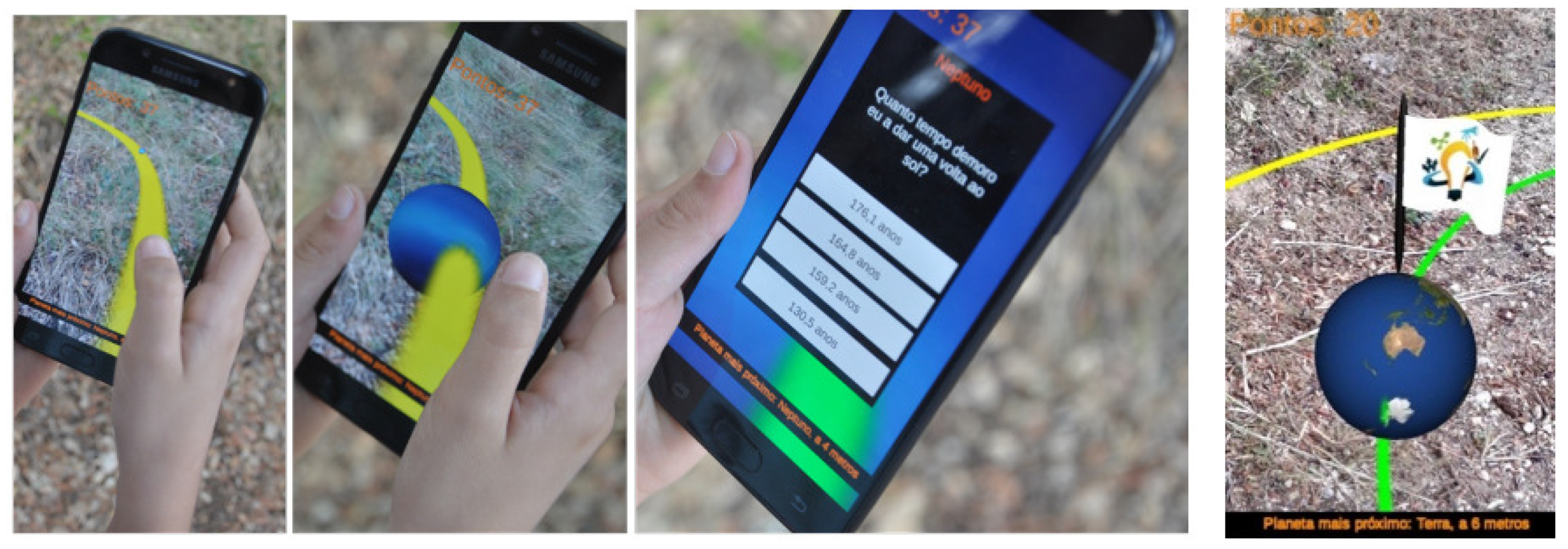
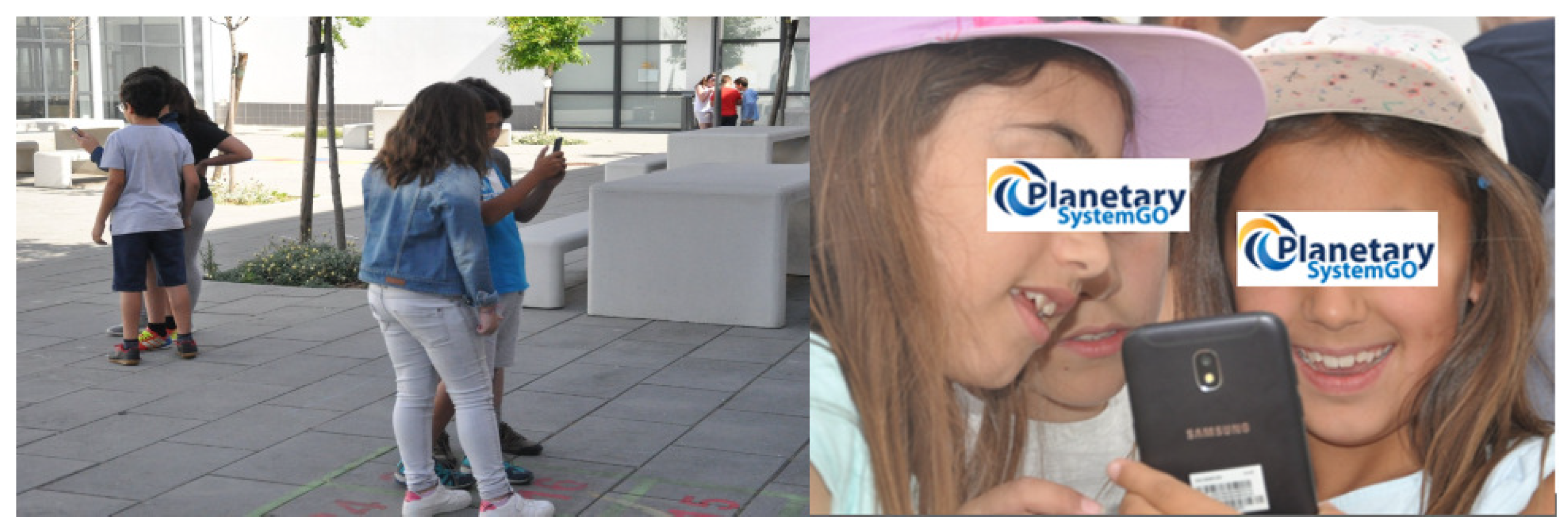
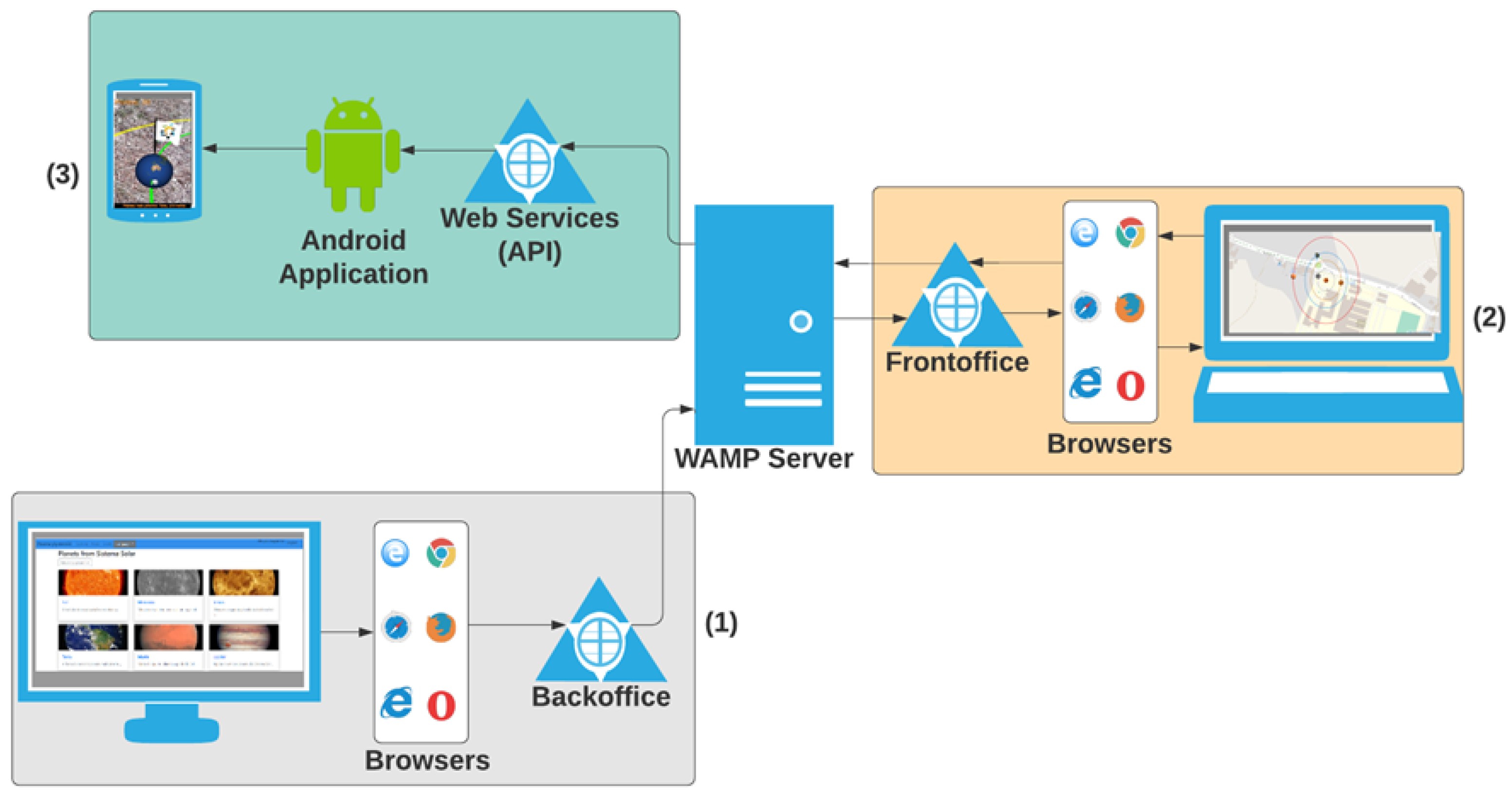
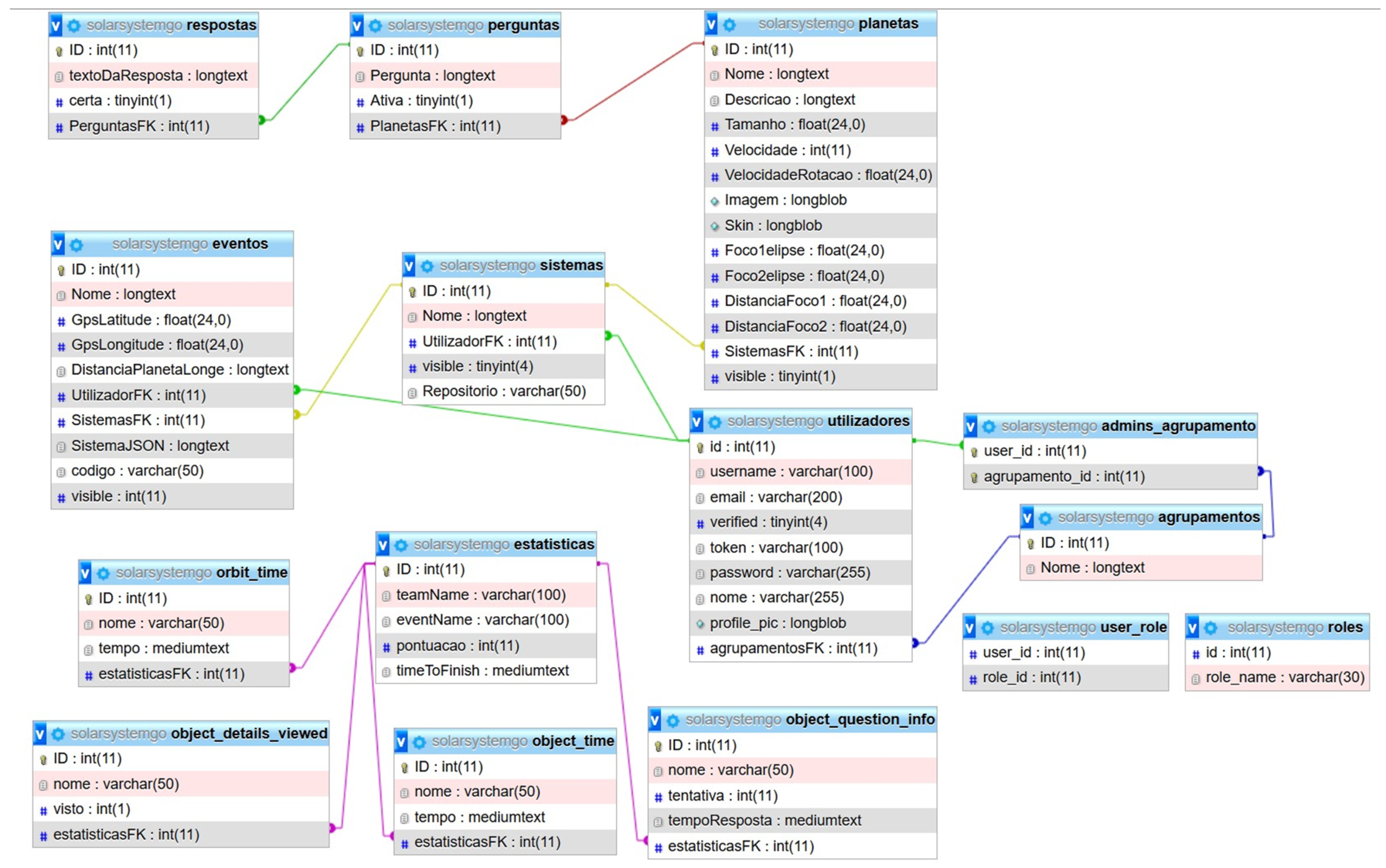
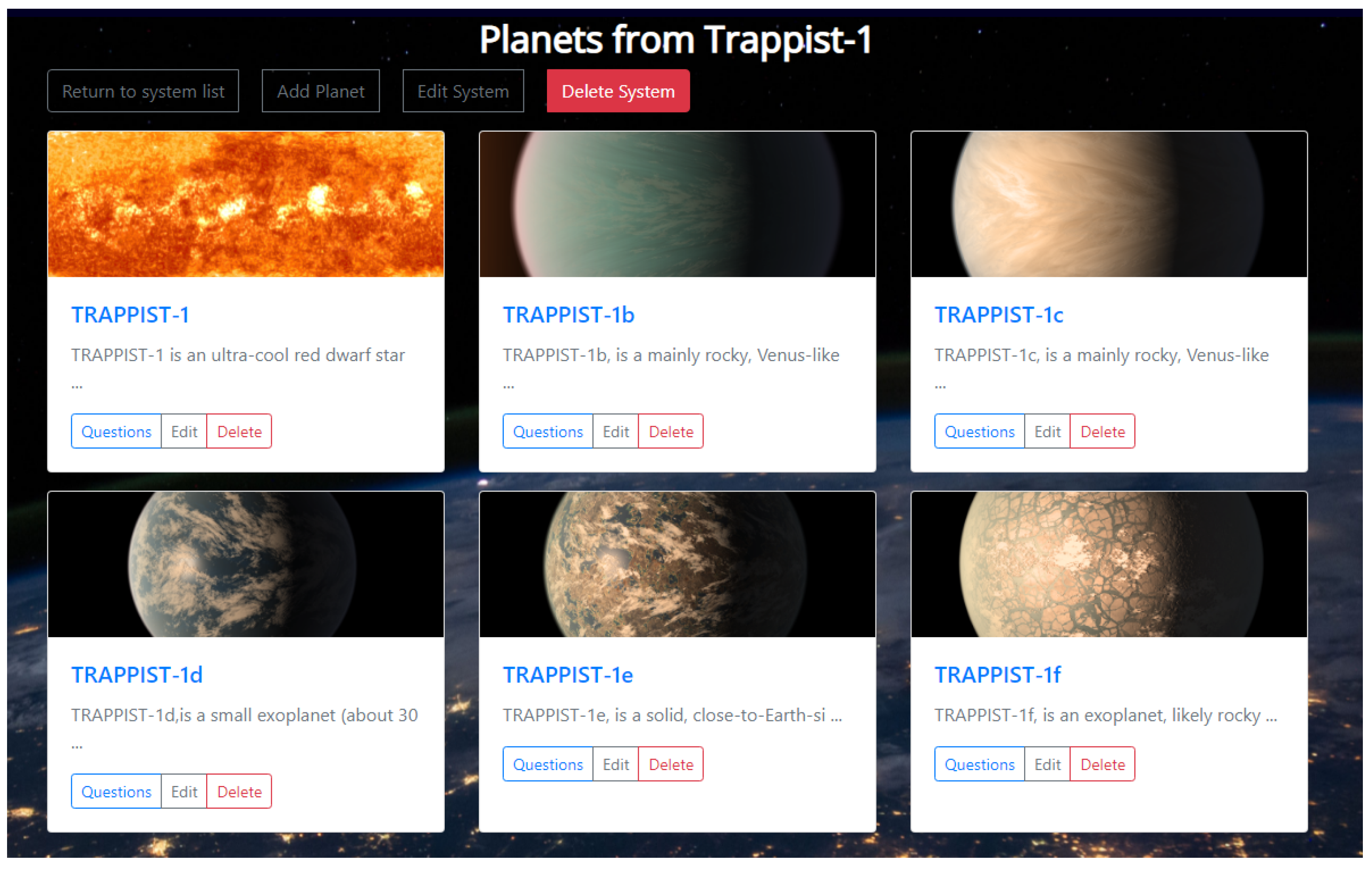
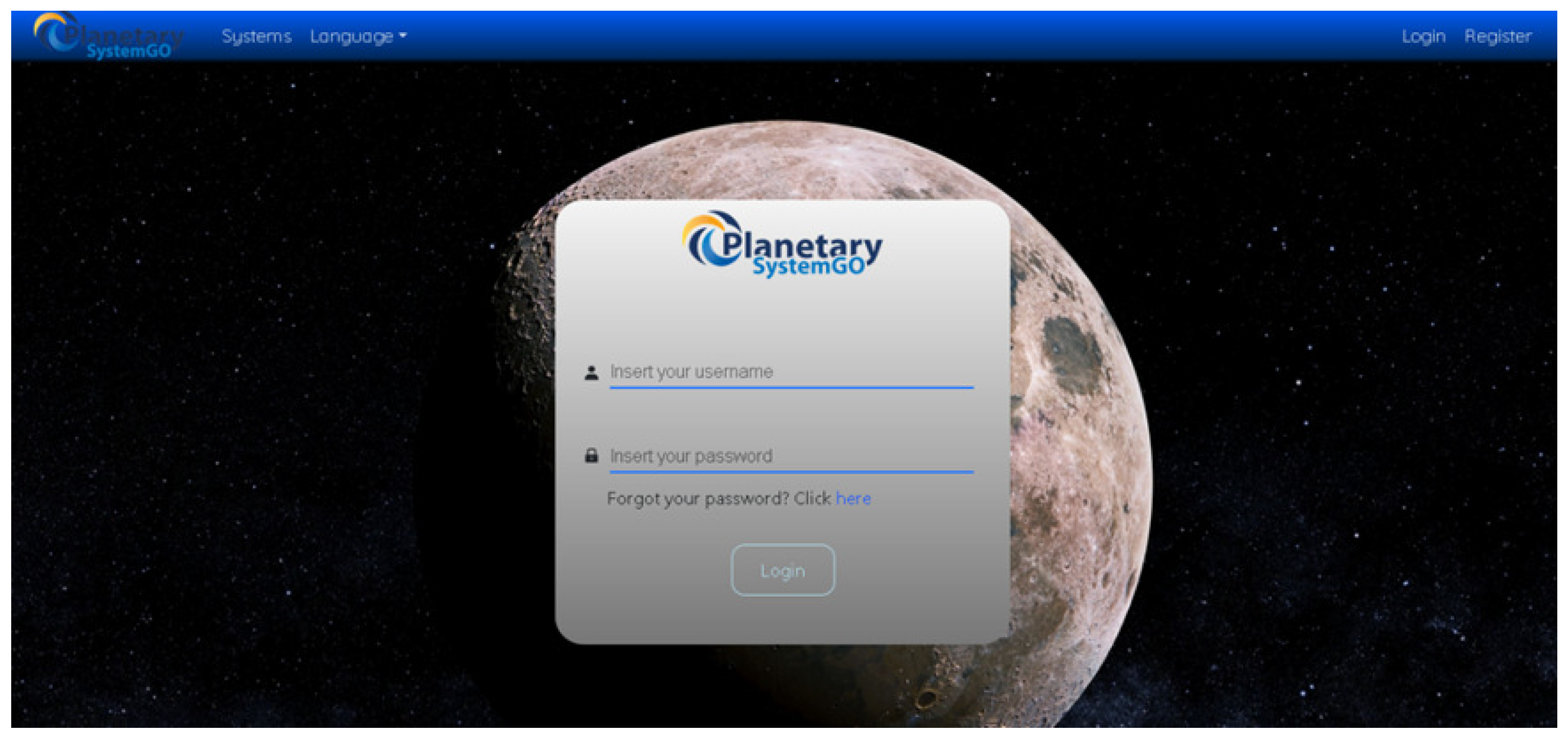
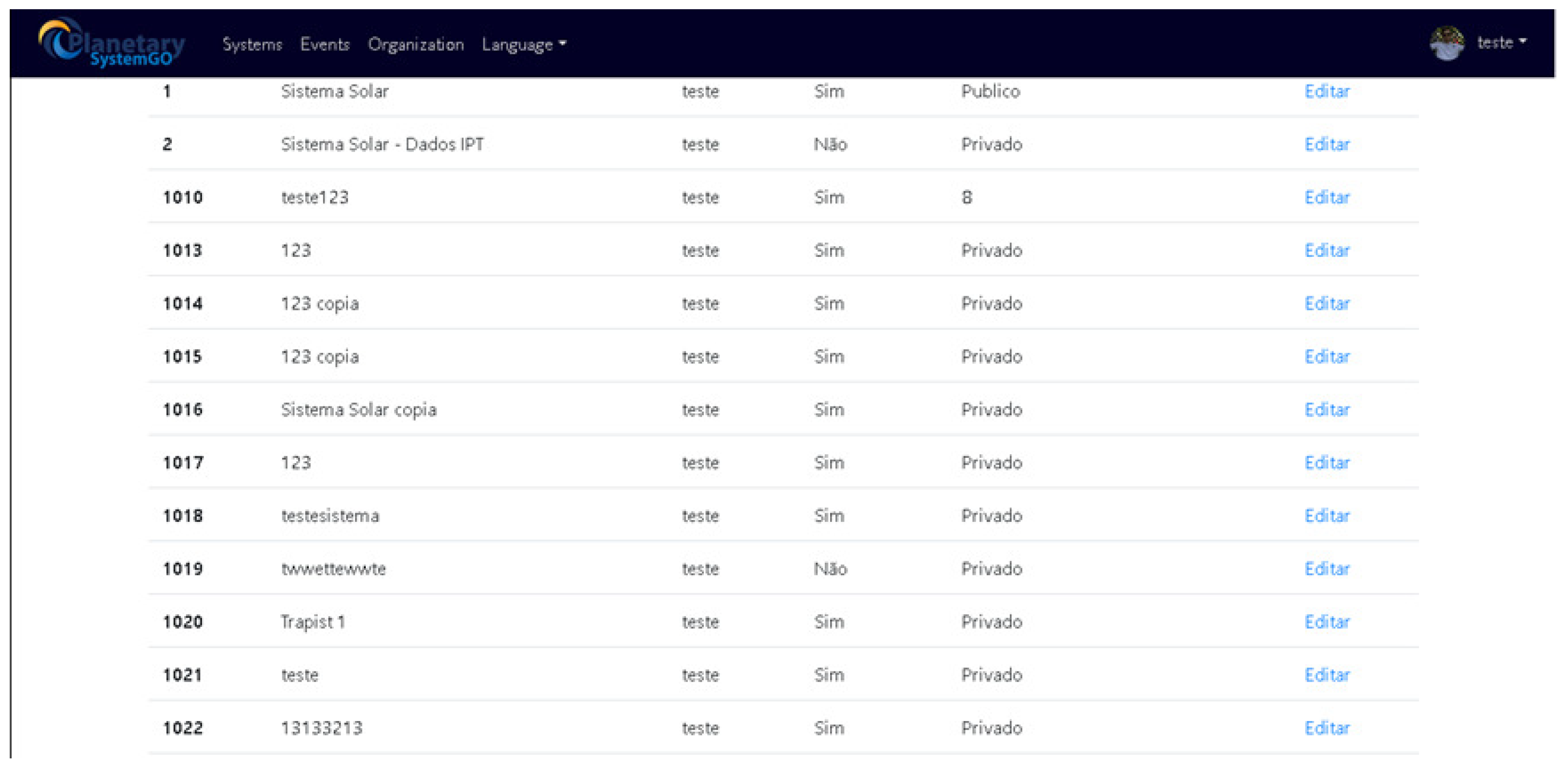
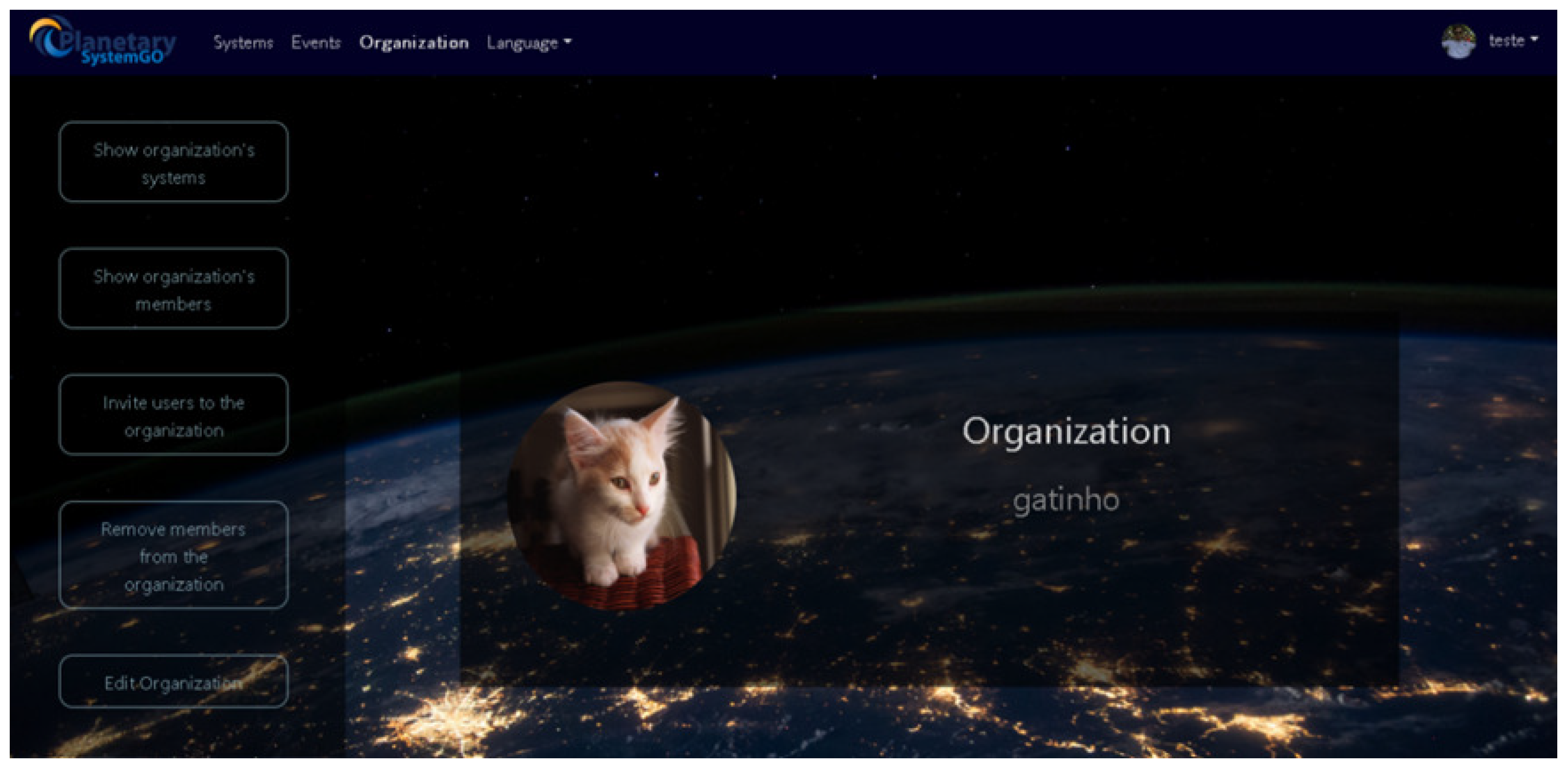
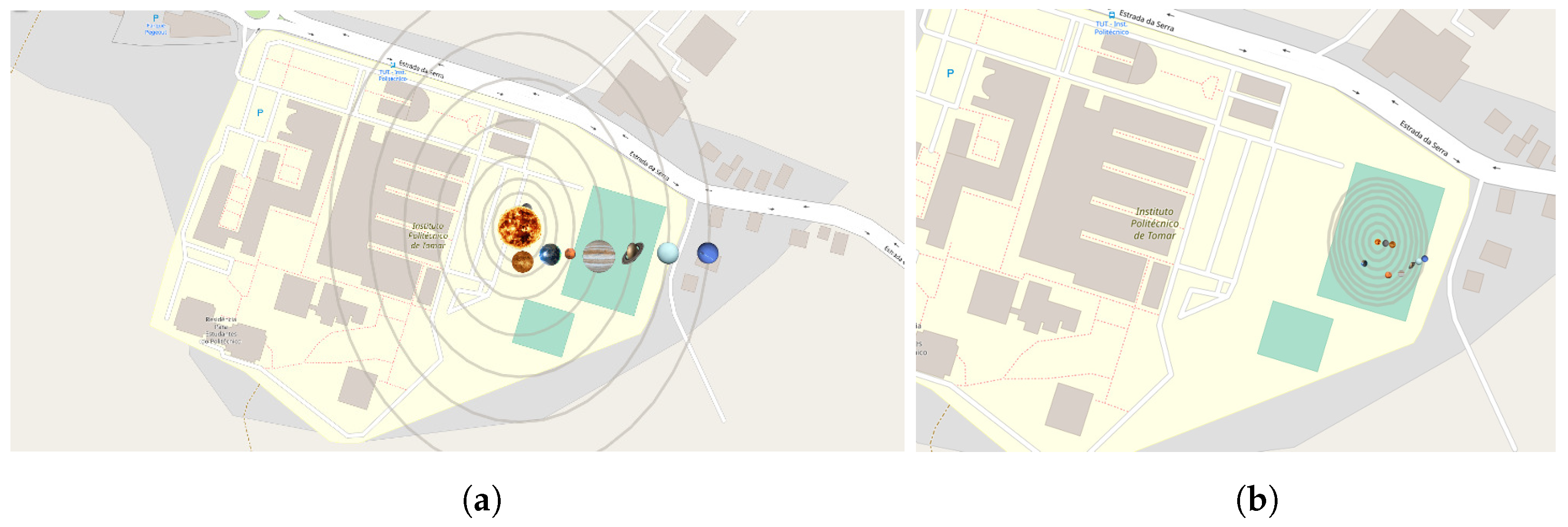
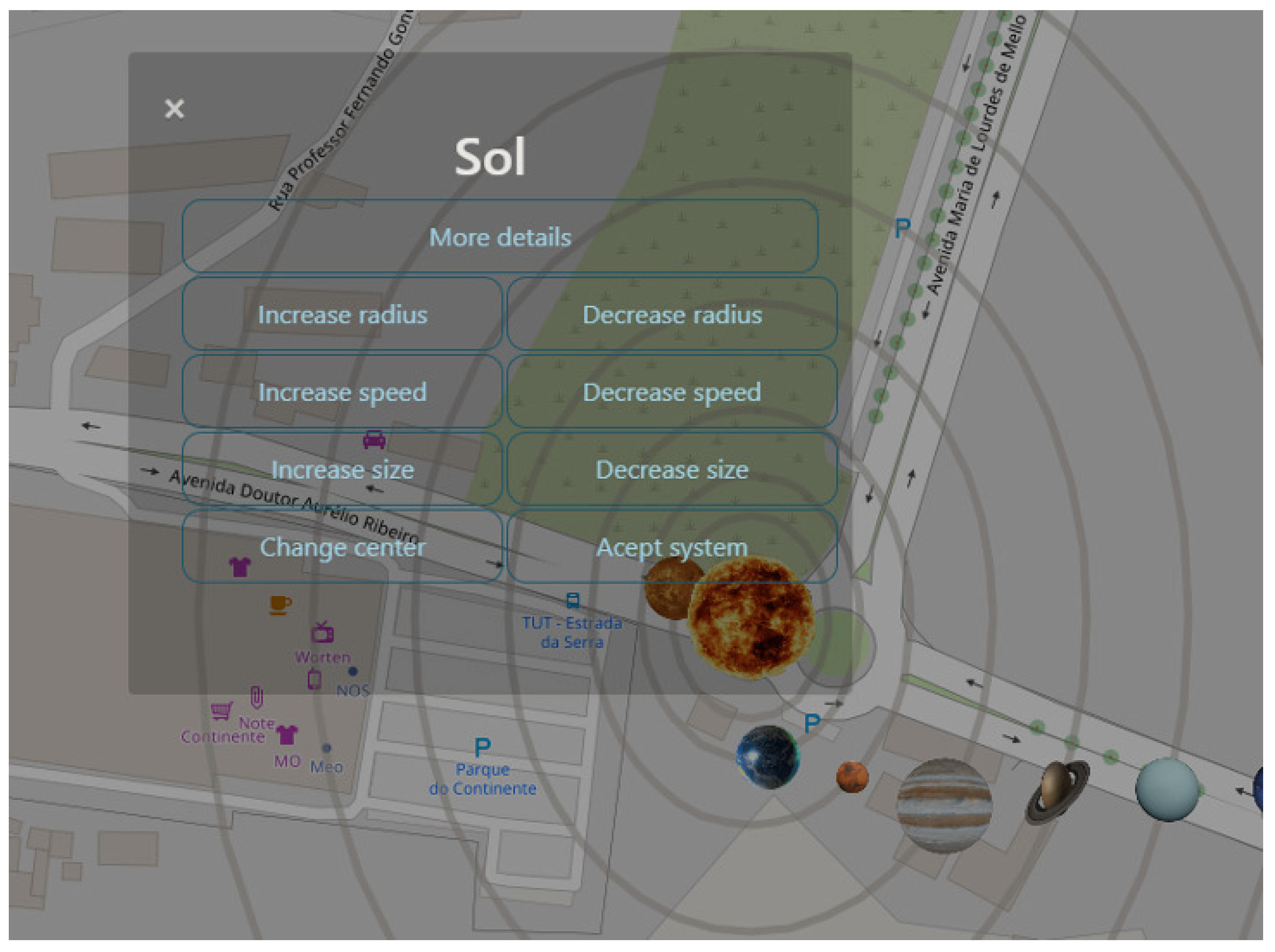
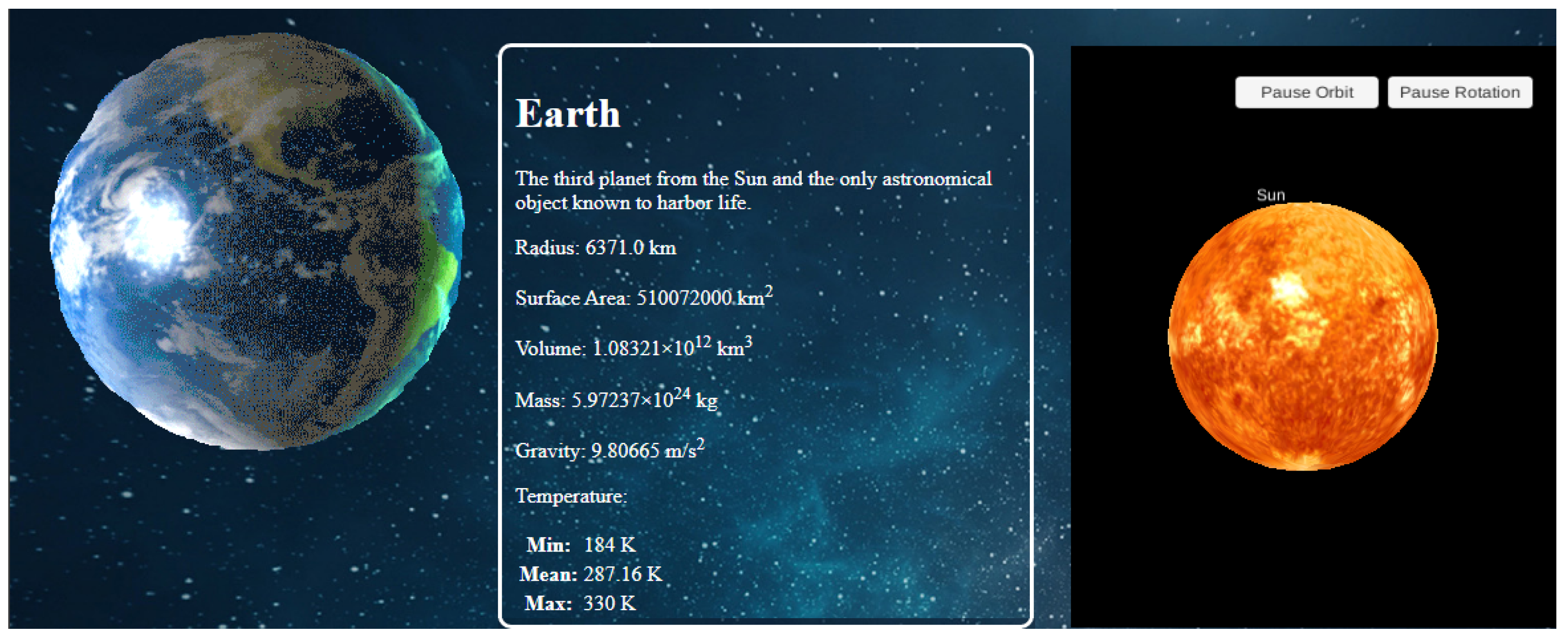
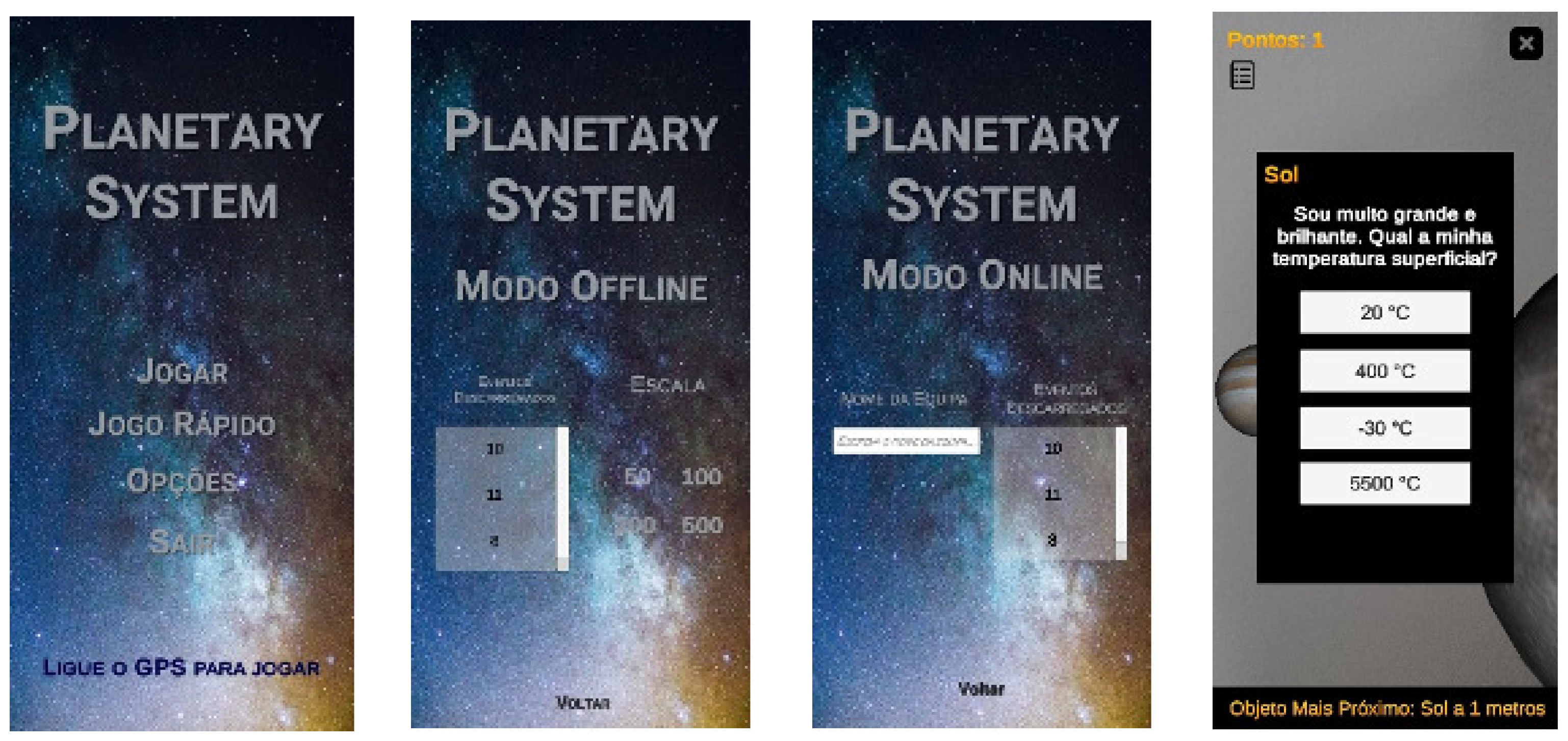
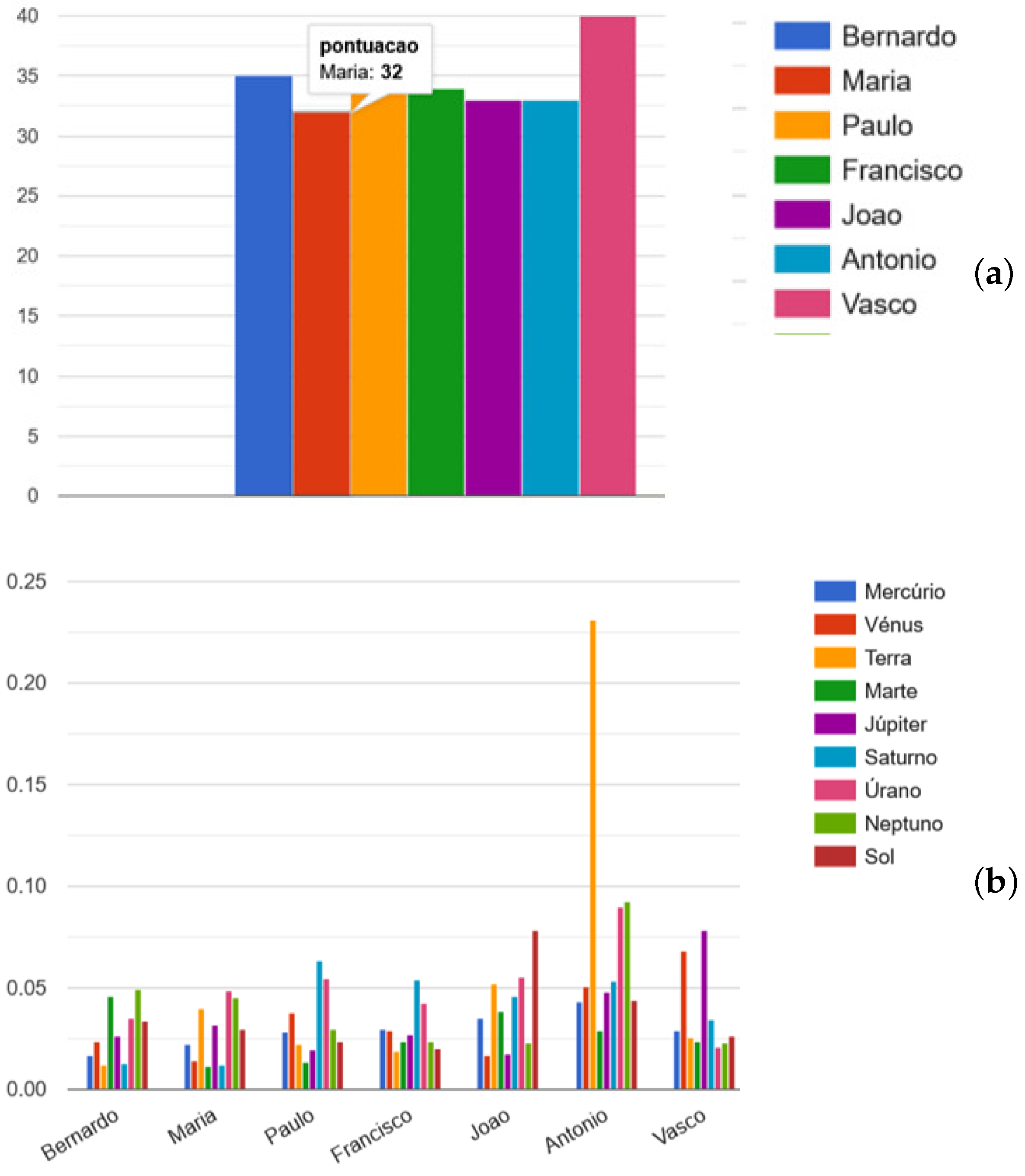
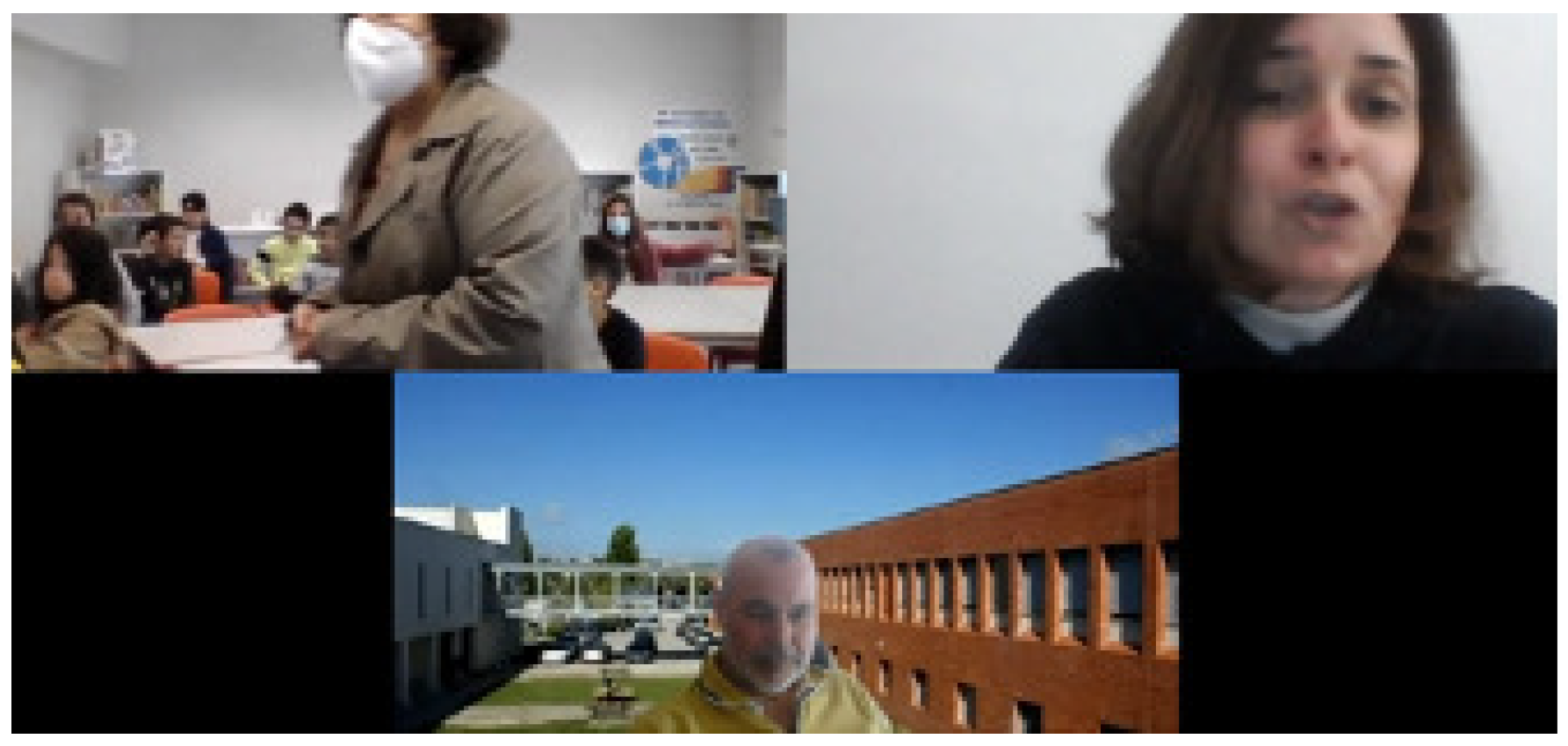
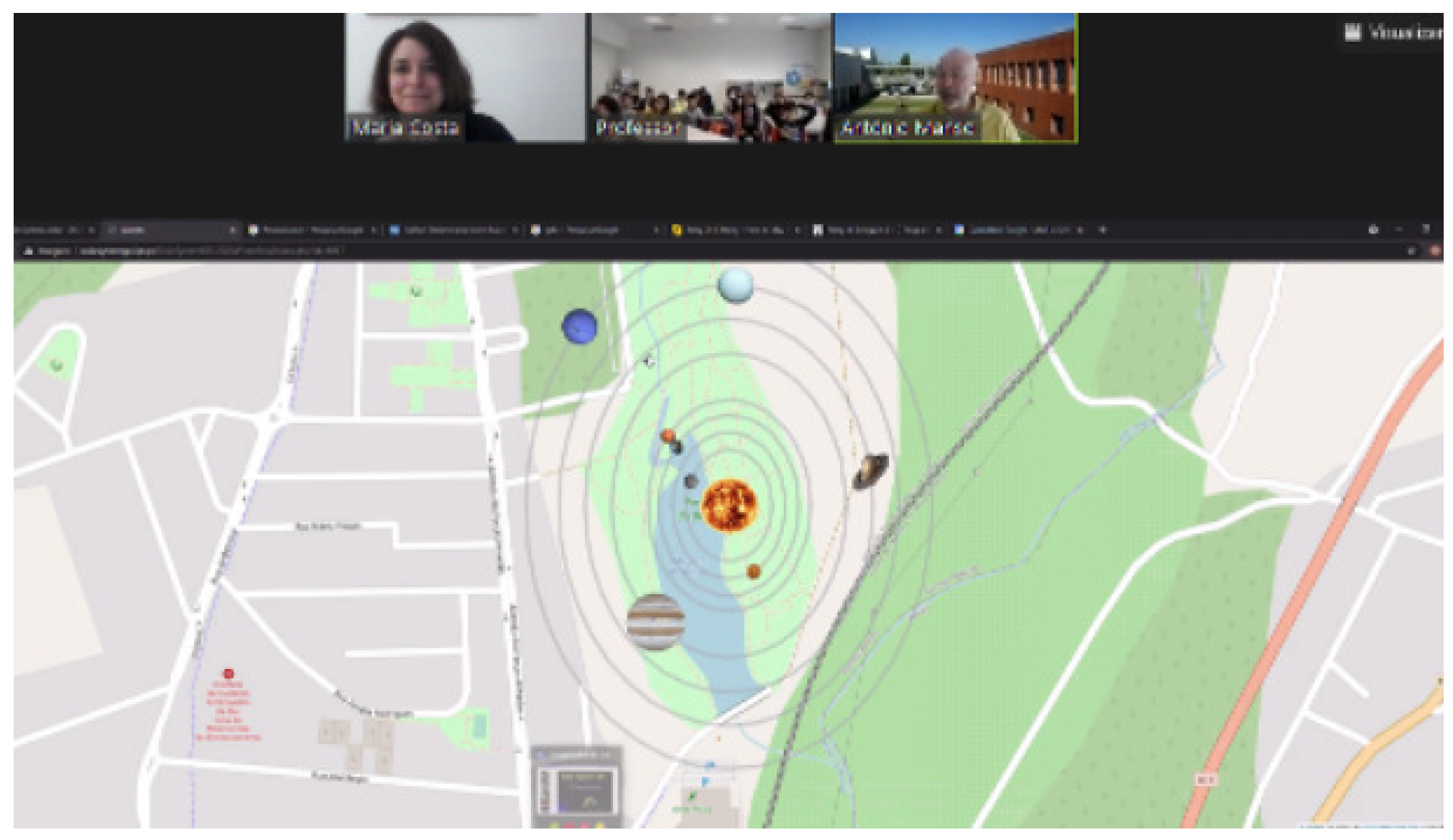


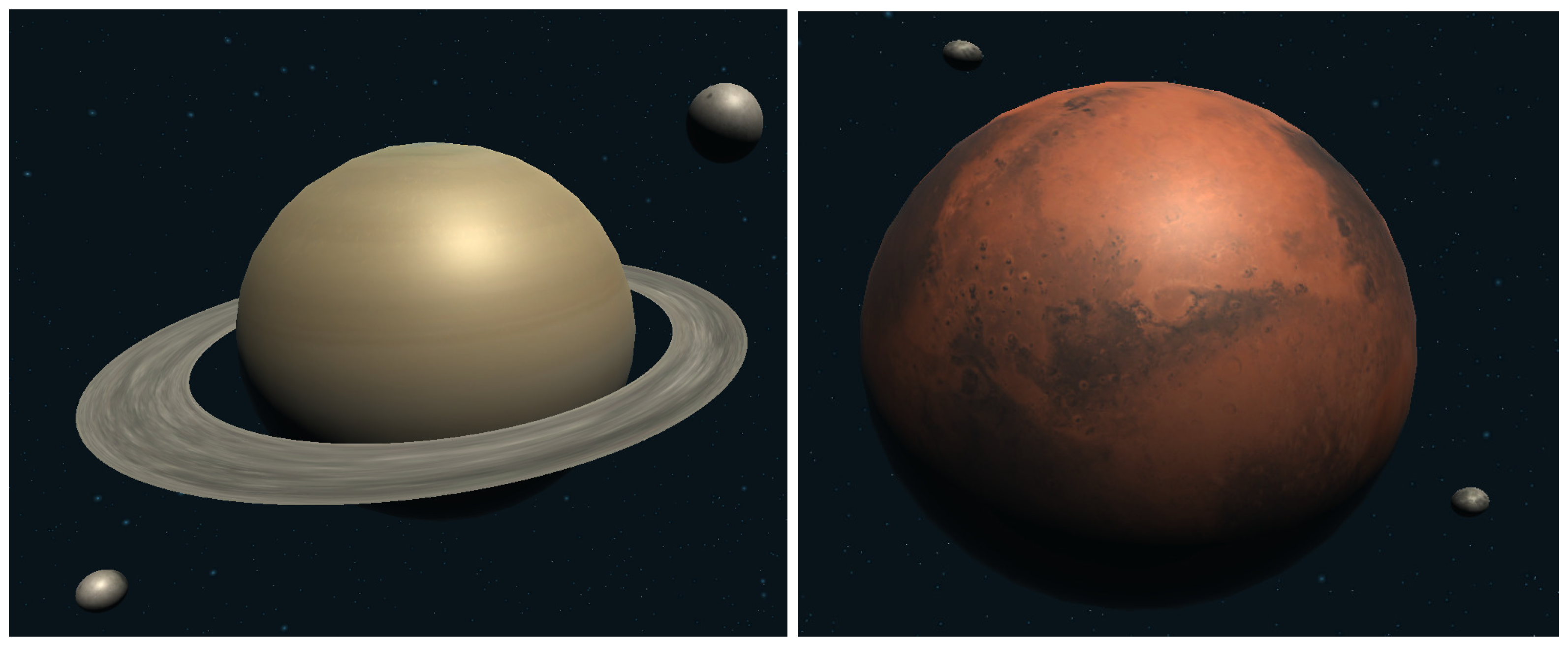


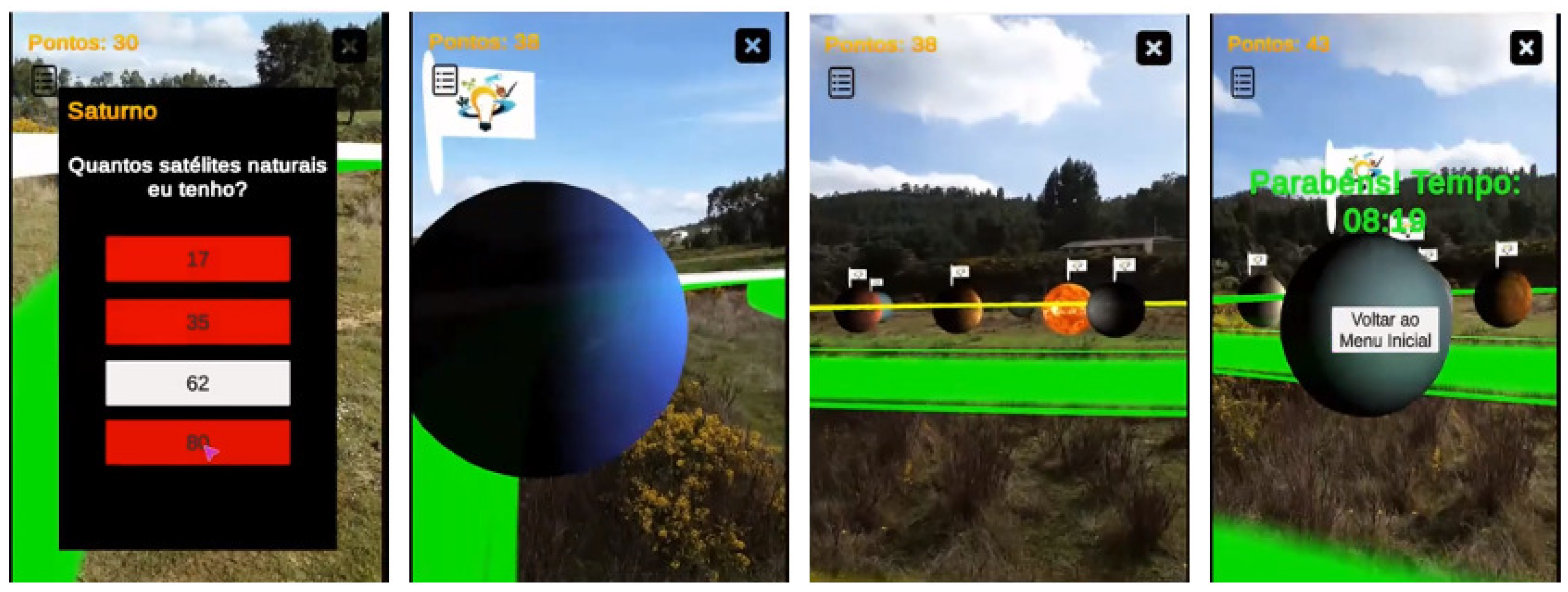

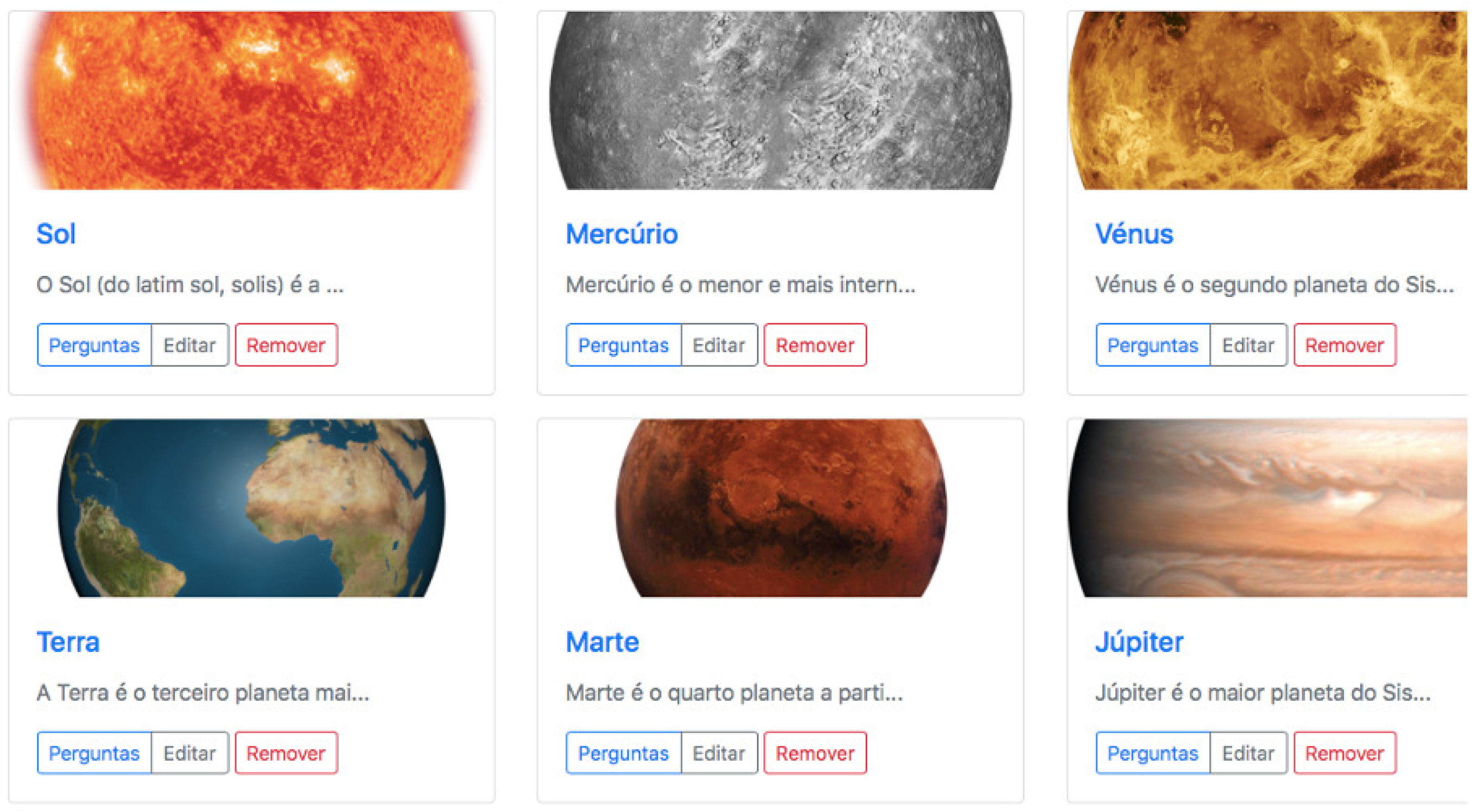
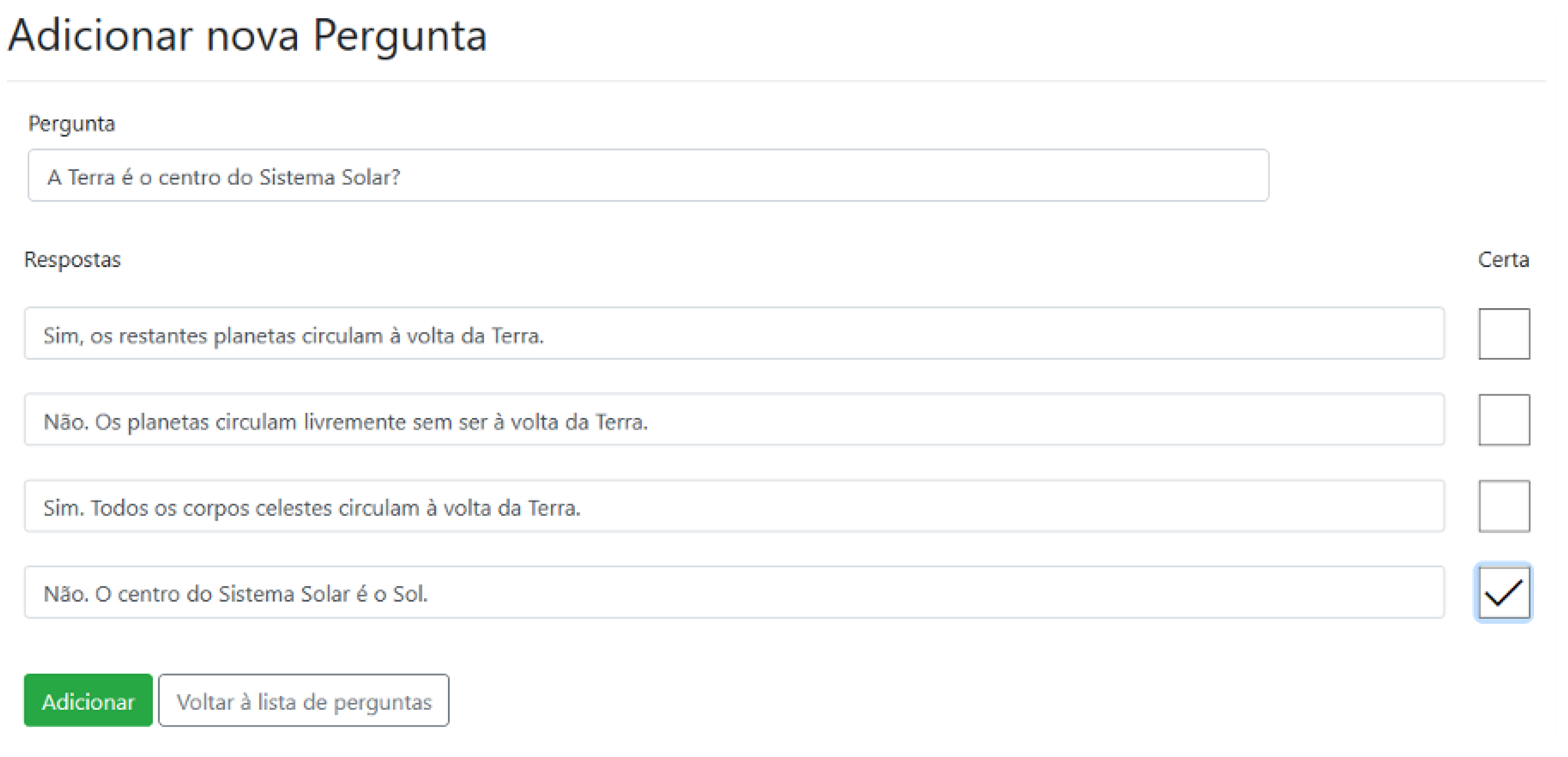
| Age Range | ≤30 | 30–40 | 40–50 | 50–55 | 55–60 |
|---|---|---|---|---|---|
| Frequency | 1 (6.3%) | 3 (18.8%) | 5 (31.3%) | 5 (31.3%) | 2 (12.5%) |
| Grade Level | 1st | 2nd | 3rd | 4th | 5th | 6th | ES 1st to 4th |
|---|---|---|---|---|---|---|---|
| Frequency | 3 | 4 | 3 | 3 | 0 | 2 | 1 |
| (18.8%) | (25%) | (18.8%) | (18.8%) | (0%) | (12.5%) | (6.3%) |
| Question | Type | Main Result |
|---|---|---|
| Q1 | Yes/No | 15 (93.8%) for “No” |
| Q2 | Likert scale | 16 (100%) for ≥ “Important” |
| Q3 | Likert scale | 16 (100%) for ≥ “Important” |
| Q4 | Likert scale | 16 (100%) for ≥ “Important” |
| Q5 | Open question | — |
| Not Important | Little Important | Important | Very Important | Very Much Important | |
|---|---|---|---|---|---|
| Q2 | 4 (25%) | 8 (50%) | 4 (26.7%) | ||
| Q3 | 2 (12.5%) | 10 (62.5%) | 4 (26.7%) | ||
| Q4 | 8 (50%) | 8 (50%) |
Publisher’s Note: MDPI stays neutral with regard to jurisdictional claims in published maps and institutional affiliations. |
© 2021 by the authors. Licensee MDPI, Basel, Switzerland. This article is an open access article distributed under the terms and conditions of the Creative Commons Attribution (CC BY) license (https://creativecommons.org/licenses/by/4.0/).
Share and Cite
Costa, M.C.; Santos, P.; Patrício, J.M.; Manso, A. An Interactive Information System That Supports an Augmented Reality Game in the Context of Game-Based Learning. Multimodal Technol. Interact. 2021, 5, 82. https://doi.org/10.3390/mti5120082
Costa MC, Santos P, Patrício JM, Manso A. An Interactive Information System That Supports an Augmented Reality Game in the Context of Game-Based Learning. Multimodal Technologies and Interaction. 2021; 5(12):82. https://doi.org/10.3390/mti5120082
Chicago/Turabian StyleCosta, Maria Cristina, Paulo Santos, João Manuel Patrício, and António Manso. 2021. "An Interactive Information System That Supports an Augmented Reality Game in the Context of Game-Based Learning" Multimodal Technologies and Interaction 5, no. 12: 82. https://doi.org/10.3390/mti5120082
APA StyleCosta, M. C., Santos, P., Patrício, J. M., & Manso, A. (2021). An Interactive Information System That Supports an Augmented Reality Game in the Context of Game-Based Learning. Multimodal Technologies and Interaction, 5(12), 82. https://doi.org/10.3390/mti5120082








